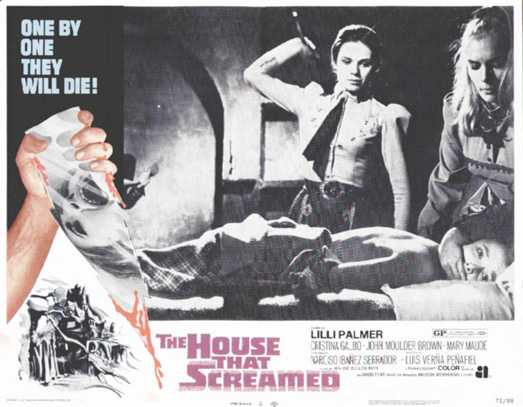|
The House That Screamed Film review by Thomas M. Sipos |
|
MENU Books Horror Film Festivals and Awards
Pursuits
Blogs Horror Film Festivals and Awards
Other
|
The House That Screamed (Spanish 1969, dir: Chicho Ibaqez-Serrador; cast: Lilli Palmer, Cristina Galbo, John Moulder-Brown, Mary Maude; aka La Residencia, The Finishing School, The Boarding School)
Yet in his Psychotronic Encyclopedia, Michael Weldon dismisses The House That Screamed as "a sick made-in-Spain movie." At least Tohill & Tombs recognize the film's historic importance. In Immoral Tales: European Sex and Horror Movies 1956-1984, they write: "the [Spanish] horror 'boom' really began with the success of The House That Screamed (La residencia) in 1969." But remarkably, they say no more about it, only alluding to it later when discussing Serrador's Island of Death: "Like Serrador's earlier The House That Screamed, the pacing of [Island Of Death] is excellent. ... Again, as in his earlier film, Serrador's story deals with the effects of repression and the notion that the worlds of adults and children are separated by an unbridgeable gulf." You'd think a book about European sex & horror cinema would say more about the film it credits with popularizing horror in Spain. No matter. I'll say more: The film opens with the arrival of "eighteen and a half years-old" Theresa (Cristina Galbo) at an all-girl's boarding school, in 19th century France (not Spain). She appears privileged, the school an elite academy (as in Suspiria). But the school is really an exalted dumping ground for girls who are troubled, troublesome, or just trouble. Insolent, thievish, wanton, or simply unwanted. Theresa is the latter. Diffident, even demure, but unwanted by her prostitute mother. Fortunately, someone is willing to pay her tuition to keep her out of her mother's way. Mme. Fourneau (Lilli Palmer) runs the school, with the aid of a student, Irene (Mary Maude). Irene leads a gang of lesbian bullies, who act as enforcers for Fourneau. One may infer fascist symbolism from Irene's brown blouse and black tie, and her gang's role in enforcing Fourneau's will. Being a 1969 Spanish film, The House That Screamed can easily be interpreted as metaphor for Franco's rule. The "school as metaphor for repressive politics" is an old conceit. The simpler filmic versions pit staid administrations against free-spirited students. But The House That Screamed and The Chocolate War (1988) are more complex, and darker, in that they feature school administrations and student gangs forming mutually satisfying alliances against a weak student majority. As best I know, I'm the only one to identify a political metaphor in The House That Screamed. Everyone else seemss to focus on the sex. John Stanley (Creature Features) praises the film because it "excellently captures the oppressive sexual needs of the girls with erotic artsy intercutting." Well, there's that. Actually, the film captures just about every manner of sexual need, for every character. Forneau's adolescent son, Luis (John Moulder-Brown), feels like a kid in a candy store. He skulks about and spies on the libidinal girls, crawling through walls, peering through vents as they shower. Complicating matters, Fourneau dotes on Luis, pampering him, projecting her hypochondria onto him, fretting lest he catch cold on a warm summer day. Mother warns son that "none of these girls are any good," and counsels him to wait for the right woman, who will protect him, and "live for him," and love him, just like ... mother. Then mother kiss her son on the lip.
Further complicating matters, Fourneau appears to desire one of her students. After Fourneau has Irene whip the student, Fourneau apologizes and kisses the student's freshly scarred back. Irene relishes wielding the whip, face aglow with sadistic glee. But she also uses sex to control the girls. Irene controls access to a workman, deciding which horny girl has earned the privilege to slip out for a sexual rendezvous. (For herself, Irene prefers the company of her lesbian gang.) But there are still more complications. Irene flirts with Theresa, explaining that she can make things pleasant or difficult. For things to be pleasant, all Theresa need do is "obey" Irene's every wish. This is the sexual tinderbox Theresa slowly finds herself in. (Tohill & Tombs are right to praise the pacing.) But even before Theresa's arrival, a serpent had entered Fourneau's well-ordered garden. Suspiciously too many girls are "escaping" -- and never heard from again. What began as a "exploitation boarding school film" morphs into slasher territory. The "escapes" distress Fourneau, who stands to lose her position. As control over her society disintegrates, she increases her repression, ordering all windows and doors nailed shut. "If the girls want to escape, they will," laments a maid. "This is a boarding house, not a prison." "Then I will make it a prison," Fourneau responds. When Fourneau withdraws privileges from Irene, Irene withdraws the services of her enforcers. Without Irene, the girls grow more difficult to handle. As the body count mounts, everyone wants to escape.
As political metaphor, The House That Screamed suggests that authoritarianism carries the seeds of its own destruction, in the end destroying even those who serve it. As horror film, The House That Screamed benefits from having a strong charismatic villain. No, not Fourneau, but Irene. Or rather, Irene as portrayed by Mary Maude. Mary Maude has a talent for playing charismatic meanies. As Irene, Maude is strong, alluring, aloof, regal. Maude also shone as the witch-hunter's callous wife in Terror (British 1978). But when she played a docile woman-in-distress in Crucible of Terror (British 1971) she lost her charisma, and was less interesting. Maude also appeared in La Muerte Incierta (Spanish 1972), but remains an obscure British actress. Like many European films, The House That Screamed is an international mishmash. Produced in Spain, set in France, starring the English Maude and the German Palmer. The English prints are dubbed, although the actresses' lips seem to be already speaking English. In an interview for Filmfax #75-76, Maude states: "Unfortunately, I did not dub my own voice, as I was working on something else at the time. I regret this, as I feel that only half the performance is mine. It is my understanding that the English dub was not very good. But, then again, the Spanish one wasn't much either." No digitally remastered DVD copy yet exists. Ebay used to have VHS copies of dubious quality, mostly from Europe. I purchased a VHS copy which had a copyright notice, but also a photocopied cover. That video is recorded from a washed-out film print. The reds bleed. The hi-fi soundtrack is murky. Later, a poor quality DVD was released in Australia in the PAL format. Later came the Elvira DVD version, which is happily in widescreen and in NTSC format, but still visually with what sounds like a dull, mono soundtrack. Still, The House That Screamed is worth seeing at whatever quality is available. Review copyright by Thomas M. Sipos
|
"Communist Vampires" and "CommunistVampires.com" trademarks are currently unregistered, but pending registration upon need for protection against improper use. The idea of marketing these terms as a commodity is a protected idea under the Lanham Act. 15 U.S.C. s 1114(1) (1994) (defining a trademark infringement claim when the plaintiff has a registered mark); 15 U.S.C. s 1125(a) (1994) (defining an action for unfair competition in the context of trademark infringement when the plaintiff holds an unregistered mark).








